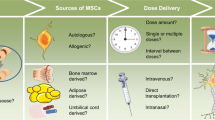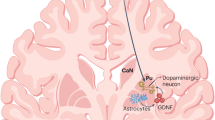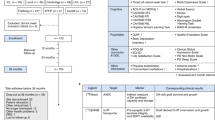Abstract
Parkinson’s disease (PD) is a neurodegenerative disease that affects more than 1% of people over the age of 60. The principal feature of this disease is the progressive loss of dopaminergic neurons (DAn) within the nigrostriatal system, causing the motor symptoms observed in these patients. At present, there is no therapeutic approach with a cytoprotective effect that can prevent DAn cell death or disease progression. Cell replacement therapy began 30 years ago with the objective to compensate for the loss of DAn by transplantation of dopamine-producing cells. The results from these trials have provided proof of concept of safety and efficacy of cell replacement. However, a major limiting factor of this strategy has been the poor survival rate of grafted DAn. An important factor that could cause cell death of DA precursors is the host response to the graft. In this review, we discuss the factors that affect the outcome of cell therapy in PD, with focus on the cell types used and the functional effects of the host immune response on graft survival and differentiation. We also discuss the strategies that may increase the efficacy of cell replacement therapy which target the host immune response.
This is a preview of subscription content, access via your institution
Access options
Subscribe to this journal
Receive 12 print issues and online access
$259.00 per year
only $21.58 per issue
Buy this article
- Purchase on Springer Link
- Instant access to full article PDF
Prices may be subject to local taxes which are calculated during checkout


Similar content being viewed by others
References
Lesage S, Brice A. Parkinson's disease: from monogenic forms to genetic susceptibility factors. Hum Mol Genet. 2009;18(R1):R48–59.
Obeso JA, Rodriguez-Oroz MC, Goetz CG, Marin C, Kordower JH, Rodriguez M, et al. Missing pieces in the Parkinson’s disease puzzle. Nat Med. 2010;16:653–61.
Coelho M, Ferreira JJ. Late-stage Parkinson disease. Nat Rev Neurol. 2012;8:435–42.
Hassanzadeh K, Rahimmi A. Oxidative stress and neuroinflammation in the story of Parkinson’s disease: Could targeting these pathways write a good ending? J Cell Physiol. 2018;234:23–32.
GBD 2015 Neurological Disorders Collaborator Group. Global, regional, and national burden of neurological disorders during 1990-2015: a systematic analysis for the Global Burden of Disease Study 2015. Lancet Neurol. 2017;16:877–97.
Dorsey ER, Bloem BR. The Parkinson pandemic—a call to action. JAMA Neurol. 2018;75:9–10.
Wenker SD, Leal MC, Farías MI, Zeng X, Pitossi FJ. Cell therapy for Parkinson’s disease: Functional role of the host immune response on survival and differentiation of dopaminergic neuroblasts. Brain Res. 2016;1638:15–29.
Valldeoriola F, Puig-Junoy J, Puig-Peiró R. Workgroup of the SCOPE study. Cost analysis of the treatments for patients with advanced Parkinson’s disease: SCOPE study. J Med Econ. 2013;16:191–201.
Gardner J. A history of deep brain stimulation: technological innovation and the role of clinical assessment tools. Soc Stud Sci. 2013;43:707–28.
Fawcett JW. Death and survival in CNS Grafting. In: Dunnett SB, Boulton AA, Baker GB, eds. Neural transplantation methods. Humana Press Inc., Totowa, NJ. United States; 2000. pp 441–60.
Björklund A, Stenevi U. Reconstruction of the nigrostriatal dopamine pathway by intracerebral nigral transplants. Brain Res. 1979;177:555–60.
Björklund A, Schmidt RH, Stenevi U. Functional reinnervation of the neostriatum in the adult rat by use of intraparenchymal grafting of dissociated cell suspensions from the substancia nigra. Cell Tissue Res. 1980;212:39–45.
McGuire P, Strecker RE, Widner H, Clarke DJ, Nilsson OG, Astedt B, et al. Human fetal dopamine neurons grafted in a rat model of Parkinson′s disease: immunological aspects, spontaneous and drug induced behaviour, and dopamine release. Exp Brain Res. 1988;70:192–208.
Wijeyekoon R, Barker RA. Cell replacement therapy for Parkinson’s disease. Biochim Biophys Acta. 2009;1792:688–702.
Björklund A, Lindvall O. Replacing Dopamine neurons in Parkinson’s disease: how did it happen? J Parkinsons Dis. 2017;7(s1):S21–S31.
Lindvall O, Björklund A. Cell therapeutics in Parkinson’s disease. Neurotherapeutics. 2011;8:539–48.
Barker RA, Barrett J, Mason SL, Bjorklund A. Fetal dopaminergic transplantation trials and the future of neural grafting in Parkinson’s disease. The Lancet Neurology. 2013;12:84–91.
Lindvall O. Developing dopaminergic cell therapy for Parkinson’s disease—give up or move forward? Mov Disord. 2013;28:268–73.
Breysse N, Carlsson T, Winkler C, Björklund A, Kirik D. The functional impact of the intrastriatal dopamine neuron grafts in parkinsonian rats is reduced with advancing disease. J Neurosci. 2007;27:5849–56.
Moore SF, Guzman NV, Mason SL, Williams-Gray CH, Barker RA. Which patients with Parkinson’s disease participate in clinical trials? One centre’s experiences with a new cell based therapy trial (TRANSEURO). J. Parkinsons Dis. 2014;4:671–6.
Barker RA, Studer L, Cattaneo E, Takahashi J, G-Force PD. consortium. G-Force PD: a global initiative in coordinating stem cell-based dopamine treatments for Parkinson’s disease. NPJ Parkinsons Dis. 2015;1:15017.
Fjodorova M, Torres EM, Dunnett SB. Transplantation site influences the phenotypic differentiation of dopamine neurons in ventral mesencephalic grafts in Parkinsonian rats. Exp Neurol. 2017;291:8–19.
Barker RA, Parmar M, Studer L, Takahashi J. Human trials of stem cell-derived dopamine neurons for Parkinson’s disease: dawn of a new era. Cell Stem Cell. 2017;21:569–73.
Sonntag KC, Song B, Lee N, Jung JH, Cha Y, Leblanc P, et al. Pluripotent stem cell-based therapy for Parkinson’s disease: current status and future prospects. Prog Neurobiol. 2018;168:1–20.
Stoker TB, Barker RA. Cell therapies for Parkinson’s disease: how far have we come? Regen Med. 2016;11:777–86.
Kim J, Su SC, Wang H, Cheng AW, Cassady JP, Lodato MA, et al. Functional integration of dopaminergic neurons directly converted from mouse fibroblasts. Cell Stem Cell. 2011;4;9:413–9.
Parmar M. Towards stem cell-based therapies for Parkinson’s disease. Development. 2018. https://doi.org/10.1242/dev.156117.
Takahashi J. Strategies for bringing stem cell-derived dopamine neurons to the clinic: The Kyoto trial. Prog Brain Res. 2017;230:213–26.
Turner M, Leslie S, Martin NG, Peschanski M, Rao M, Taylor CJ, et al. Toward the development of a global induced pluripotent stem cell library. Cell Stem Cell. 2013;13:382–4.
Solomon S, Pitossi F, Rao MS. Banking on iPSC—is it doable and is it worthwhile. Stem Cell Rev. 2015;11:1–10.
Brundin P, Karlsson J, Emgård M, Schierle GS, Hansson O, Petersén A, et al. Improving the survival of grafted dopaminergic neurons: a review over current approaches. Cell Transplant. 2000;9:179–95.
Sortwell CE, Pitzer MR, Collier TJ. Time course of apoptotic cell death within mesencephalic cell suspension grafts: implications for improving grafted dopamine neuron survival. Exp Neurol. 2000;165:268–77.
Duan WM, Westerman M, Flores T, Low WC. Survival of intrastriatal xenografts of ventral mesencephalic dopamine neurons from MHC-deficient mice to adult rats. Exp Neurol. 2001;167:108–17.
Duan WM, Westerman MA, Wong G, Low WC. Rat nigral xenografts survive in the brain of MHC class II-, but not class I-deficient mice. Neuroscience. 2002;115:495–504.
Duan WM, Widner H, Brundin P. Temporal pattern of host responses against intrastriatal grafts of syngeneic, allogeneic or xenogeneic embryonic neuronal tissue in rats. Exp Brain Res. 1995;104:227–42.
Brundin P, Nilsson OG, Gage FH, Bjorklund A. Cyclosporin A increases survival of cross-species intrastriatal grafts of embryonic dopamine-containing neurons. Exp Brain Res. 1985;60:204–8.
Galpern WR, Burns LH, Deacon TW, Dinsmore J, Isacson O. Xenotransplantation of porcine fetal ventral mesencephalon in a rat model of Parkinson’s disease: functional recovery and graft morphology. Exp Neurol. 1996;140:1–13.
Larsson LC, Czech KA, Brundin P, Widner H. Intrastriatal ventral mesencephalic xenografts of porcine tissue in rats: immune responses and functional effects. Cell Transplant. 2000;9:261–72.
Larsson LC, Frielingsdorf H, Mirza B, Hansson SJ, Anderson P, Czech KA, et al. Porcine neural xenografts in rats and mice: donor tissue development and characteristics of rejection. Exp Neurol. 2001;172:100–14.
Kriks S, Shim JW, Piao J, Ganat YM, Wakeman DR, Xie Z, et al. Dopamine neurons derived from human ES cells efficiently engraft in animal models of Parkinson’s disease. Nature. 2011;480:547–51.
Emborg ME, Liu Y, Xi J, Zhang X, Yin Y, Lu J, et al. Induced pluripotent stem cell-derived neural cells survive and mature in the nonhuman primate brain. Cell Rep. 2013a;3:646–50.
Emborg ME, Zhang Z, Joers V, Brunner K, Bondarenko V, Ohshima S, et al. Intracerebral transplantation of differentiated human embryonic stem cells to hemiparkinsonian monkeys. Cell Transplant. 2013b;22:831–8.
Ideguchi M, Shinoyama M, Gomi M, Hayashi H, Hashimoto N, Takahashi J. Immune or inflammatory response by the host brain suppresses neuronal differentiation of transplanted ES cell-derived neural precursor cells. J Neurosci Res. 2008;86:1936–43.
Hoornaert CJ, Le Blon D, Quarta A, Daans J, Goossens H, Berneman Z, et al. Concise review: innate and adaptive immune recognition of allogeneic and xenogeneic cell transplants in the central nervous system. Stem Cells Transl Med. 2017;6:1434–41.
Kikuchi T, Morizane A, Doi D, Magotani H, Onoe H, Hayashi T, et al. Human iPS cell-derived dopaminergic neurons function in a primate Parkinson’s disease model. Nature. 2017;548:592–6.
Reekmans K, De Vocht N, Praet J, Fransen E, Le Blon D, Hoornaert C, et al. Spatiotemporal evolution of early innate immune responses triggered by neural stem cell grafting. Stem Cell Res Ther. 2012;3:56.
Praet J, Santermans E, Daans J, Le Blon D, Hoornaert C, Goossens H, et al. Early inflammatory responses following cell grafting in the CNS trigger activation of the subventricular zone: a proposed model of sequential cellular events. Cell Transplant. 2015;24:1481–92.
Tomov N, Surchev L, Wiedenmann C, Döbrössy MD, Nikkhah G. Astrogliosis has different dynamics after cell transplantation and mechanical impact in the rodent model of Parkinson′s disease. Balkan Med J. 2018;35:141–7.
Morizane A, Kikuchi T, Hayashi T, Mizuma H, Takara S, Doi H, et al. MHC matching improves engraftment of iPSC-derived neurons in non-human primates. Nat Commun. 2017;8:385.
Soderstrom KE, Meredith G, Freeman TB, McGuire SO, Collier TJ, Sortwell CE, et al. The synaptic impact of the host immune response in a parkinsonian allograft model rat model: Influence on graft-derived aberrant behaviors. Neurobiol Dis. 2008;32:229–42.
Steece-Collier K, Soderstrom KE, Collier TJ, Sortwell CE, Maries-Lad E. Effect of levodopa priming on dopamine neuron transplant efficacy and induction of abnormal involuntary movements in parkinsonian rats. J Comp Neurol. 2009;515:15–30.
Clarke DJ, Branton RL. A role for tumor necrosis factor alpha in death of dopaminergic neurons following neural transplantation. Exp Neurol. 2001;176:154–62.
McGuire SO, Ling ZD, Lipton JW, Sortwell CE, Collier TJ, Carvey PM. Tumor necrosis factor alpha is toxic to embryonic mesencephalic dopamine neurons. Exp Neurol. 2001;169:219–30.
Breger LS, Kienle K, Smith GA, Dunnett SB, Lane EL. Influence of chronic L-DOPA treatment on immune response following allogeneicand xenogeneic graft in a rat model of Parkinson’s disease. Brain Behav Immun. 2017;61:155–64.
Horrocks LA, Yeo YK. Health benefits of docosahexaenoic acid (DHA). Pharmacol Res. 1999;40:211–25.
Bazan NG. Docosanoids and elovanoids from omega-3 fatty acids are pro-homeostatic modulators of inflammatory responses, cell damage and neuroprotection. Mol Aspects Med. 2018;64:18–33.
Chang YL, Chen SJ, Kao CL, Hung SC, Ding DC, Yu CC, et al. Docosahexaenoic acid promotes dopaminergic differentiation in inducedpluripotent stem cells and inhibits teratoma formation in rats with Parkinson-likepathology. Cell Transplant. 2012;21:313–32.
He XB, Kim M, Kim SY, Yi SH, Rhee YH, Kim T, et al. Vitamin C facilitates dopamine neuron differentiation in fetal midbrain through TET1 and JMJD3-dependent epigenetic control manner. Stem Cells. 2015;33:1320–32.
Wulansari N, Kim EH, Sulistio YA, Rhee YH, Song JJ, Lee SH. Vitamin C-induced epigenetic modifications in donor NSCs establish midbrain marker expressions critical for cell-based therapy in Parkinson’s disease. Stem Cell Rep. 2017;9:1192–206.
Rodriguez-Pallares J, Rodriguez-Perez AI, Muñoz A, Parga JA, Toledo-Aral JJ, Labandeira-Garcia JL. Effects of Rho kinase inhibitors of grafts of dopaminergic cell precursors in a rat model of Parkinson’s disease. Stem Cells Transl Med. 2016;5:804–15.
Moriarty N, Cabré S, Alamilla V, Pandit A, Dowd E. Encapsulation of young donor age dopaminergic grafts in a GDNF-loaded collagen hydrogel further increases their survival, reinnervation, and functional efficacy after intrastriatal transplantation in hemi-Parkinsonian rats. Eur J Neurosci. 2018. https://doi.org/10.1111/ejn.14090.
Adil MM, Vazin T, Ananthanarayanan B, Rodrigues GMC, Rao AT, Kulkarni RU, et al. Engineered hydrogels increase the post-transplantation survival of encapsulated hESC-derived midbrain dopaminergic neurons. Biomaterials. 2017;136:1–11.
Moriarty N, Pandit A, Dowd E. Encapsulation of primary dopaminergic neurons in a GDNF-loaded collagen hydrogel increases their survival, reinnervation and function after intra-striatal transplantation. Sci Rep. 2017;7:16033.
Furlanetti LL, Cordeiro JG, Cordeiro KK, García JA, Winkler C, Lepski GA, et al. Continuous high-frequency stimulation of the subthalamic nucleus improves cell survival and functional recovery following dopaminergic cell transplantation in rodents. Neurorehabil Neural Repair. 2015;29:1001–12.
Politis M, Wu K, Loane C, Quinn NP, Brooks DJ, Rehncrona S, et al. Serotonergic neurons mediate dyskinesia side effects in Parkinson’s patients with neural transplants. Sci Transl Med. 2010;2:38ra46.
Politis M, Wu K, Loane C, Brooks DJ, Kiferle L, Turkheimer FE, et al. Serotonergic mechanisms responsible for levodopa-induced dyskinesias in Parkinson′s disease patients. J Clin Invest. 2014;124:1340–9.
Kirkeby A, Parmar M, Barker RA. Strategies for bringing stem cell-derived dopamine neurons to the clinic: a European approach (STEM-PD). Prog Brain Res. 2017;230:165–90.
Parmar M, Torper O, Drouin-Ouellet J. Cell-based therapy for Parkinson’s disease: A journey through decades towards the light side of the Force. Eur J Neurosci. 2018. https://doi.org/10.1111/ejn.14109.
Studer L. Strategies for bringing stem cell-derived dopamine neurons to the clinic-The NYSTEM trial. Prog Brain Res. 2017;230:191–212.
Peng J, Liu Q, Rao MS, Zeng X. Survival and engraftment of dopaminergic neurons manufactured by a Good Manufacturing Practice-compatible process. Cytotherapy. 2014;16:1305–12.
Acknowledgements
SDW and FJP are members of the research career of CONICET.
Funding
National Agency for Scientific and Technologic Promotion (ANPCYT, Argentina), National Scientific and Technical Research Council (CONICET, Argentina).
Author information
Authors and Affiliations
Corresponding author
Ethics declarations
Conflict of interest
The authors declare that they have no conflict of interest.
Additional information
Publisher’s note: Springer Nature remains neutral with regard to jurisdictional claims in published maps and institutional affiliations.
Rights and permissions
About this article
Cite this article
Wenker, S.D., Pitossi, F.J. Cell therapy for Parkinson′s disease is coming of age: current challenges and future prospects with a focus on immunomodulation. Gene Ther 27, 6–14 (2020). https://doi.org/10.1038/s41434-019-0077-4
Received:
Revised:
Accepted:
Published:
Issue Date:
DOI: https://doi.org/10.1038/s41434-019-0077-4
This article is cited by
-
Co-transplantation of autologous Treg cells in a cell therapy for Parkinson’s disease
Nature (2023)
-
Cellular and Molecular Mechanisms Underly the Combined Treatment of Fasudil and Bone Marrow Derived-Neuronal Stem Cells in a Parkinson’s Disease Mouse Model
Molecular Neurobiology (2023)
-
Nanomaterials for neurodegenerative diseases: Molecular mechanisms guided design and applications
Nano Research (2022)



